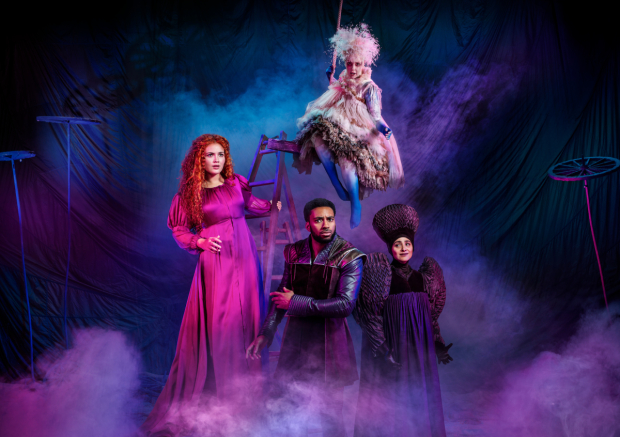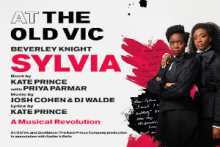What does it take to get a musical right?

© Mark Senior
However, rather than contenting themselves with reproducing what audiences were relishing earlier in the year, the creative team, headed by director Tania Azevedo and producers Paul Taylor-Mills and Bill Kenwright, have reappraised the material, and made some changes to further hone and streamline their product. It’s a canny but balanced move, ensuring that musical theatre completists and BIAC fans head back to check out what’s been altered, plus of course to see, and no doubt offer online opinions on, the new company.
The changes are primarily cosmetic (fans needn’t fret: Alexzandra Sarmiento’s energised choreography and David Shield’s candy-coloured visual aesthetic, such vital components first time around, are largely unchanged, and the score retains it’s high octane bounce) but what has emerged is a leaner, slightly more outrageous BIAC. One number in what had been a lengthy first half has been cut entirely while some others have been condensed at no loss to their overall effect. A rip-roaring act two sequence ‘Step Five’ which trod a line between hilarious and uncomfortable as the gay teens in “therapy” are encouraged to simulate sexual situations to free their inner heterosexuality, is now completely different (it’s arguably funnier now, and it’s certainly more explicit). The original also had a “Dream Ballet”, which was a witty nod to classic old school musicals but looked a little cramped on the Turbine stage. The idea is still there but it’s now just a moment rather than a full blown dance sequence.
But I’m A Cheerleader had benefited from being developed at MTFestUK, Paul Taylor-Mills’s annual workshop showcase for new musical work. Every year up to eight new shows in embryonic form are put in front of audiences to see what works and what doesn’t. It’s an invaluable stepping stone in the journey to stage for any new piece of work in this most elusive, tricky and costly-to-produce of genres. On the other side of the pond, organisations such as the New York Theatre Workshop (where such smash hits as Rent, Once and Hadestown first saw light of day), Manhattan’s Second Stage (Next To Normal, Dear Evan Hansen) and Public Theater (Hair, A Chorus Line, Hamilton) provide similarly fertile environments for the development of new musicals.
Another stage in the genesis of fledgling work is the out-of-town tryout. Shows polish themselves in front of audiences in regional cities away from the unforgiving critical glare of Broadway or the West End, so that they’re in (hopefully) great shape by the time they reach their final destination. Sometimes the changes made are minor, sometimes fundamental (for instance, a new musical entitled Away We Go! that garnered tepid reviews in New Haven in 1943 had been rechristened Oklahoma! by the time it rode triumphantly onto Broadway later that year). The logistics and expense of transporting ever more elaborate, technically complex physical productions – the gargantuan iron foundry that housed Hal Prince’s vision for Sweeney Todd, John Napier’s outsized revolving junkyard (Cats), and his railroad that encompassed an entire auditorium in Starlight Express are just a couple of examples – mean that this valuable developmental stage was largely abandoned for a couple of decades, but it’s very much back now. Moulin Rouge! played Boston prior to Broadway, and Disney’s Aladdin started off in Seattle and Toronto, while two of the West End’s most beloved current hits, & Juliet and Back To The Future, debuted in Manchester, and Great British Bake Off – The Musical, seen in Cheltenham back in the summer, has just announced a run at the Noël Coward next year.
Several mega-musicals of the 80s and 90s would undoubtedly have benefitted from this early work rather than opening cold. One such is Claude-Michel Schönberg and Alain Boublil’s Martin Guerre, which is planning a return in the near future. The show has a fascinating history. Intended to complete a trinity of global smash hits for the team (including producer Cameron Mackintosh) behind Les Mis and Miss Saigon (both of which underwent some changes in the course of their original London runs, but nothing compared to what happened here), this ambitious saga of mistaken identity, religious persecution and doomed love in rural medieval France premiered in a massive Declan Donnellan staging at the Prince Edward in 1996. Following hostile reviews and bemused audiences, Mackintosh closed the show for a couple of weeks, did a lot of work on it, including adding a rousing choral number “Working On The Land” in place of the original downbeat ending, then re-opened it with a whole new press night. The new reviews were a lot more favorable and the show went on to win the Best Musical Olivier. Martin Guerre also has the unusual distinction of being perhaps the only show with an original cast album where the female lead is sung not by the original star (Juliette Caton) but by her acclaimed alternate, Rebecca Lock, who has since become a West End stalwart.
The work on Martin Guerre didn’t just stop there however. When a new cast, headed by Jenna Russell, took over for the second year, the show had another, more radical, overhaul which saw new lyrics, characters cut, and whole sections repositioned to tell the story differently, resulting in a streamlined, more dramatically propulsive and ultimately more moving production. Unfortunately, the dye was cast by this point and poor old Martin was irreparably perceived as Boublil and Schönberg’s also-ran, and the show was pulled. Yet another version, with a completely different director and design team, opened subsequently at West Yorkshire Playhouse (now Leeds Playhouse), which made even more changes, including the addition of a ballad “How Many Tears” which became a bit of a standard thanks to Maria Friedman and Joanna Riding’s impassioned versions of it, in the Hey Mr Producer concert and the Leeds production respectively. That production toured with some success but the upcoming version (and who even knows what iteration we’ll get this time!) will be the first time the show has been seen in London in over 25 years.

© All images are copyright Dan Wooller, 2019
Almost as complete an overhaul was what Mackintosh effected on the original London version of The Witches of Eastwick. An entrancing and gargantuan spectacle when it opened at Drury Lane in 2000, it was only doing middling business, so the canny producer moved it to the Prince of Wales, a theatre half the size, and had the creative team completely redesign the show for the new space. What had been airy, chocolate boxy and literal became dark, glittering and abstract. Also, the male lead Daryl Van Horne’s 11 o’clock number changed from the jazzy, sleazy “Who’s The Man?” to the uplifting, Gospel-inspired “The Glory Of Me”, which also served as a usefully lively finale ultimo to send audiences dancing out into the night.
Andrew Lloyd Webber also has form in tinkering with his shows even after they have already had full scale premiere productions. His Sunset Boulevard, which opened to decent but not spectacular West End reviews with Patti LuPone in 1993, was rejigged and partly redesigned for an LA premiere starring Glenn Close the following year. When that garnered the sort of acclaim ALW had always wanted, the London production was closed, retooled to bring it in line with the darker, more dynamic American version, and then, like Martin Guerre, had another press night, this time starring Broadway diva Betty Buckley. The ensuing legal battles and bad blood between LuPone and Lloyd Webber is, of course, the stuff of theatrical legend.
Lloyd Webber’s Phantom sequel Love Never Dies also underwent extensive revisions after opening….Ramin Karimloo’s standout “Til I Hear You Sing” was moved from its spot half way through act one up to the opening of the show once it became clear that it was the number audiences were going mad for. The definitive version of the show didn’t arrive however until a year later with the Australian premiere, partially rewritten, in a completely different production, one that was filmed and was the basis of the recent North American tour. The melody to the title song from Love Never Dies is actually recycled from an earlier Lloyd Webber musical (the 1970s Belfast-set The Beautiful Game, co-written with Ben Elton which presented the Northern Ireland troubles against a football background) where it was the power ballad “Our Kind Of Love” originated by Hannah Waddingham in the West End premiere. That show, more of a critical and artistic success than a commercial one, is another example of ALW’s mania for revision, as it is now reworked and licensed (and played in Canada and in a season at London’s tiny Union Theatre) under the title The Boys In The Photograph. It will be interesting to see just how different Bad Cinderella (formerly just plain Cinderella, the most recent Lloyd Webber effort) is when it arrives on Broadway next year…

© National Theatre
Coming up in London, and returning to the same stages they previously played upon, with the same production teams and some of their original casts, are two shows that never officially opened to the press on their first outings. Hex, the National Theatre’s darkly imaginative take on the Sleeping Beauty, and Sylvia, the Old Vic’s rap and reggae-infused musical life of Emmeline Pankhurst’s daughter starring Beverley Knight, have both been extensively workshopped since their first appearances, and are now finally deemed ready to take on the glare of critical appraisal. Anybody who saw the initial versions will undoubtedly be fascinated to see how these new musicals have developed over the last twelve months and four years respectively.
All credit then to the BIAC team, and the creatives working on Hex, Sylvia, GBBO and a host of other upcoming projects for striving to make their musicals the best that they can be, exemplifying Sondheim’s statement that “musical comedies aren’t written, they are rewritten”. It’s a valid point: perhaps more than any other theatrical art form, musicals have so many components – script, songs, concept, frequently each element the responsibility of discrete collaborators- that it can take a couple of iterations for the elements to gel into a cohesive, satisfying whole. There’s a lot to get right, but a lot to look forward to.















